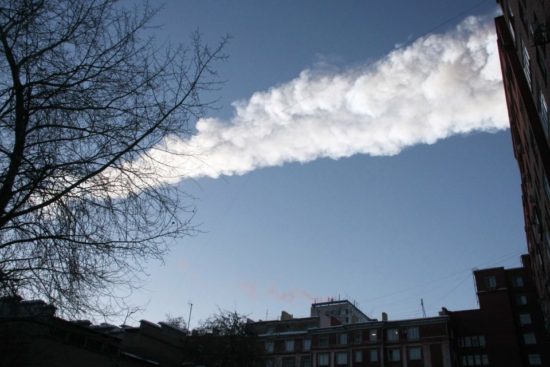An asteroid capable of destroying Washington D.C. and New York City at the same time will be making its closest approach to Earth on April 19.
At a half-mile wide, it will have over 30,000 times as much mass as the 2013 meteor which exploded over Russia in 2013:

Smoke trail high in the stratosphere from the meteor that exploded over Chelyabinsk, Russia in 2013.
The current asteroid, called “2014 JO25“, is traveling at the unimaginably fast speed of 75,000 mph. It has been estimated that an asteroid of this size is capable of wiping out an area the size of New England, and causing global cooling from the dust that would be lofted into the stratosphere. “2014 JO25” will be the closest appoach asteroid of this size in the last 13 years.
Good News, Bad News
The good news is that even at closest approach, the asteroid — about the size of the Rock of Gibraltar — will safely pass by about 4.6 times as far away from Earth as the moon.
The bad news is that this asteroid was only discovered in 2014, and even if it was on a collision course with Earth, there probably would not have been enough time to mount a mission to hit it with a nuclear-weapon tipped rocket. This is why NASA has been surveying the skies, discovering new asteroids on a routine basis. While most of these are small, the relatively recent discovery of Wednesday’s asteroid suggests we will not have much time to respond if we discover one on a collision course with Earth. I suspect we will eventually have a rocket designed and ready for an intercept, just in case.
Here’s a time lapse video of a very close approach of a small (100 ft. diameter) asteroid in 2013, taken with a camera using a “normal” 50 mm lens (I will be attempting something similar with a telephoto lens and star tracking, weather permitting). The asteroid is the slowly moving object traversing the left side; the fast object with a glowing trail on the right side is a large meteor:

 Home/Blog
Home/Blog



